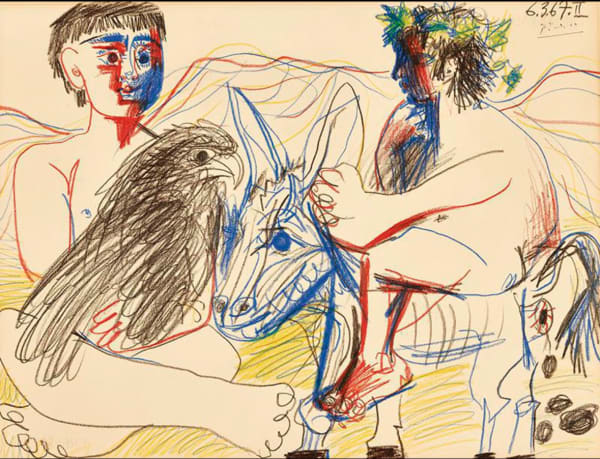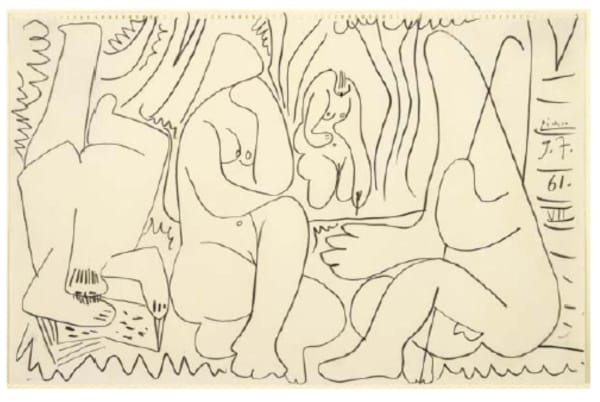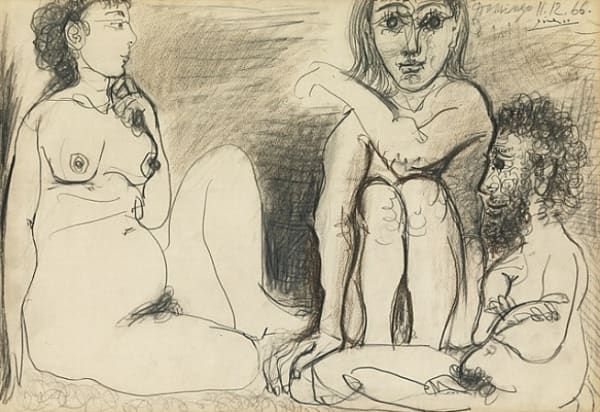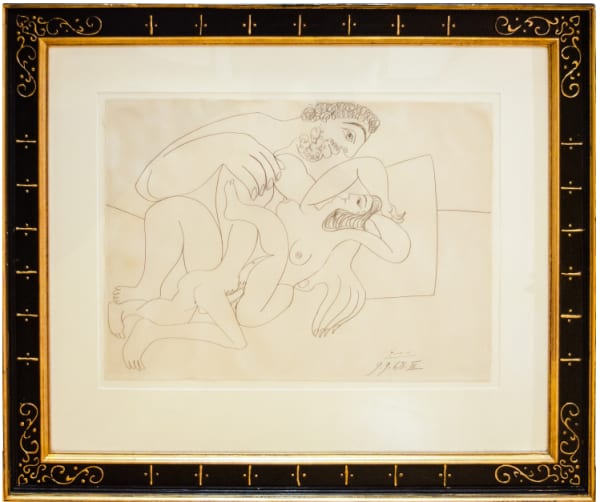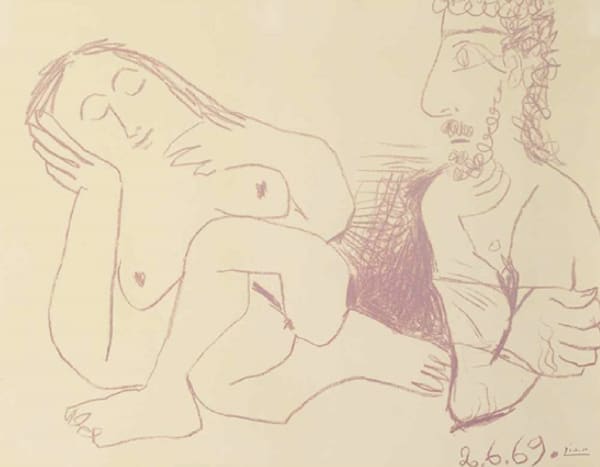
Pablo Picasso
Signed and dated
55.9 x 73.7 cm
Trois hommes et femme nus (Three Men and Nude Woman), created by Pablo Picasso on May 19, 1967, is a spirited and sensual late-period drawing that showcases the artist’s enduring fascination with the nude figure, theatrical composition, and mythic archetypes. Executed in coloured crayon and wash on paper, the work exemplifies Picasso’s vibrant late style, where expressive line and stylised form replace the more analytic structure of his earlier Cubism. This scene, simultaneously erotic, comedic, and classical, draws on themes Picasso revisited throughout his life—desire, masculinity, and the gaze—filtered through the lens of an aging artist with undiminished vitality.
The composition is dense with interwoven bodies and complex gesture. On the left, a voluptuous nude woman sits with her head tilted downward, eyes closed in a gesture of sleep or contemplation. Her form, outlined in sweeping curves and dense hatching, contrasts with the more angular, upright figures of the three nude men to her right. These men—bearded, crowned with laurel-like curls, and postured in various stances—evoke classical or mythic identities: gods, satyrs, or aging poets.
Picasso renders the figures in confident blue crayon and fluid ink wash, combining solid line with shaded textures. The hatched and crosshatched patterns, particularly around limbs and torsos, impart dimensionality and rhythm, creating a dance of visual movement across the surface. Despite the crowded scene, each figure retains individuality and psychological weight.
The artist’s technique is loose and improvisational, yet highly deliberate. The wash provides tonal atmosphere, softening the starkness of line while giving the composition warmth and volume. This juxtaposition of the linear and the gestural is a hallmark of Picasso’s mature graphic style.
Thematically, Trois hommes et femme nus revisits Picasso’s lifelong preoccupation with the dynamics between men and women—desire, voyeurism, and the act of looking. The sleeping or introspective woman recalls the archetype of the muse, passive yet central, while the three men surrounding her suggest the artist himself in various guises. Their animated expressions and gestures imply a theatrical narrative—perhaps a seduction, a debate, or an allegory of artistic creation.
There are echoes here of the classical bacchanal, of Rubens and Titian, but also of Manet’s Le Déjeuner sur l’herbe, which Picasso famously reinterpreted in several series. The figures are not realistic but symbolic—avatars of masculinity and femininity, power and contemplation.
This kind of pictorial theatre, which blends mythology, eroticism, and absurdity, became increasingly prominent in Picasso’s late 1960s work. It reflects both his encyclopedic knowledge of art history and his embrace of a freer, more instinctual mode of expression.
By 1967, Picasso was in his mid-80s, working with extraordinary productivity. Far from slowing down, he pushed further into personal mythology and expressive drawing. Trois hommes et femme nus is characteristic of this period: gestural, raw, humorous, and deeply rooted in the body.
Unlike the intense abstraction of his Cubist years or the formal clarity of his Neoclassical phase, this work embodies what could be called Picasso’s "late figuration"—a mode in which form is elastic, sensual, and emotionally charged. The use of crayon and wash on paper, rather than oil on canvas, also emphasizes immediacy and intimacy.
Trois hommes et femme nus stands as a rich, multifaceted work from Picasso’s late career. With minimal tools—coloured crayon, wash, and paper—he conjures a world of myth, eroticism, and theatrical presence. The drawing reaffirms Picasso’s genius for reinvention and his tireless exploration of the human form, even in the twilight of his life. It is both an homage to classical traditions and a defiant declaration of personal expression, etched in confident, living line.
For more information, contact our galleries via the inquiry form below.
-
 Pablo PicassoThe Foot Bath | Le Bain de pieds, 1960
Pablo PicassoThe Foot Bath | Le Bain de pieds, 1960 -
 Pablo PicassoFemme tenant un journal, 1915
Pablo PicassoFemme tenant un journal, 1915 -
 Pablo PicassoTrois Personnages,, 1954
Pablo PicassoTrois Personnages,, 1954 -
 Pablo PicassoQuatre têtes d’élégantes (Four Elegant Heads), c. 1899
Pablo PicassoQuatre têtes d’élégantes (Four Elegant Heads), c. 1899 -
 Pablo PicassoLes déjeuners,, 1961
Pablo PicassoLes déjeuners,, 1961 -
 Pablo PicassoTête de faune, 1958
Pablo PicassoTête de faune, 1958 -
 Pablo PicassoTeenager, eagle and donkey, 1967
Pablo PicassoTeenager, eagle and donkey, 1967 -
 Pablo PicassoLes Dejeuners, 1961
Pablo PicassoLes Dejeuners, 1961 -
 Pablo PicassoTrois Personnages nus Assis, 1966
Pablo PicassoTrois Personnages nus Assis, 1966 -
 Pablo PicassoHomme et Femme, 1926
Pablo PicassoHomme et Femme, 1926 -
 Pablo PicassoL’Etreinte, 1968
Pablo PicassoL’Etreinte, 1968 -
 Pablo Picasso·Toros, 1961
Pablo Picasso·Toros, 1961 -
 Pablo Picasso·Étude pour la Suite Des Déjeuners III, 1959
Pablo Picasso·Étude pour la Suite Des Déjeuners III, 1959 -
 Pablo PicassoLe déjeuner, 1962
Pablo PicassoLe déjeuner, 1962 -
 Pablo PicassoLes déjeuners,, 1961
Pablo PicassoLes déjeuners,, 1961 -
 Pablo PicassoHomme Assis, 1971
Pablo PicassoHomme Assis, 1971 -
 Pablo PicassoBust of Naked Man and Woman, 1969
Pablo PicassoBust of Naked Man and Woman, 1969
Join our mailing list
* denotes required fields
We will process the personal data you have supplied in accordance with our privacy policy (available on request). You can unsubscribe or change your preferences at any time by clicking the link in our emails.
This website uses cookies
This site uses cookies to help make it more useful to you. Find out more about cookies.






